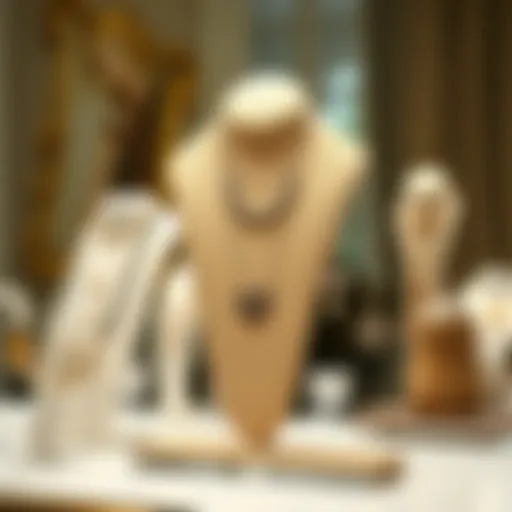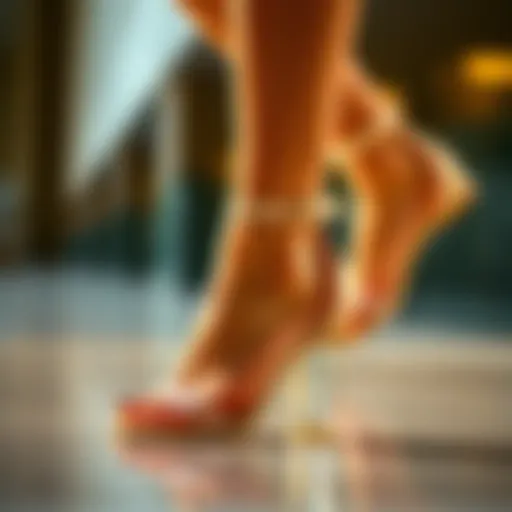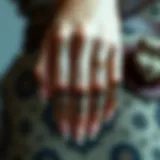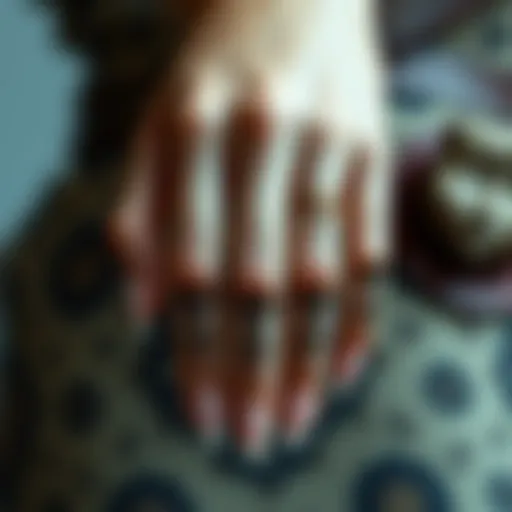The Versatile Role of Hook and Loop Strips in Fashion


Intro
In the realm of fashion, innovation often dances in tandem with practicality. The hook and loop strip, more commonly recognized by its brand name, Velcro, is a prime example of this. While many see it as just a simple fastening solution, its influence reaches far beyond the basic function. By weaving its way through various designs and applications, it has quite literally reshaped how clothing and accessories are created and utilized.
Today's fashion landscape bears testimony to a unique amalgamation of creativity and utility. As designers inch towards sustainability and versatility, hook and loop strips are increasingly relevant. Whether in sportswear, high fashion, or everyday street style, these strips are the unsung heroes, quietly but effectively catering to a diverse audience.
Unpacking the technicalities of hook and loop strips offers an entire world that influences not just how garments are worn, but also how they are made. By taking a closer look at current trends, practical advice on integrating hook and loop strips into fashion, and anticipated shifts in future applications, one gains a broader understanding of this versatile fastening mechanism.
Let’s delve deeper into these nuances and examine how hook and loop strips fit into the tapestry of modern fashion.
Intro to Hook and Loop Strips
In the ever-evolving landscape of fashion, innovation often redefines how we think about materials and their applications. Among these innovations is the humble yet remarkable hook and loop strip. These fastening solutions carry significance that extends beyond mere convenience; they embody a fusion of practicality and design ingenuity. As the fashion industry grapples with sustainability challenges and the need for versatile design solutions, understanding hook and loop strips can provide valuable insights for designers, stylists, and retail workers alike.
The utility of hook and loop strips lies primarily in their adaptability. Unlike traditional buttons and zippers, their ease of use makes them appealing not just for children's clothing but also for sophisticated fashion pieces. They allow for adjustable fits and seamless integration, creating designs that prioritize both style and functionality. Fashion creators are constantly on the lookout for ways to innovate, and the charm of hook and loop strips lies in their potential to inspire creative solutions without compromising the aesthetic quality of garments.
Yet, while they may seem simple, a deep dive into their definition and functionality reveals much about why they remain relevant in today's fashion scene. Their versatile nature is matched by a rich historical context that informs their development and usage across various cultures and styles. From high fashion runways to everyday wear, these fastening mechanisms have played a pivotal role in shaping the garments we see today.
Ultimately, exploring hook and loop strips through a multi-faceted lens of utility not only enlightens readers about their characteristics but also stirs a conversation on how such elements can influence the future of fashion.
Definition and Functionality
Hook and loop strips consist of two components: the hook side, which boasts tiny, upward-facing hooks, and the loop side, featuring soft, plush loops that catch the hooks. When pressed together, the two components create a secure fastening that is both adjustable and easy to release. This mechanism finds applications across various sectors, but its role in fashion is particularly fascinating.
Their primary functionality is striking. They can easily be sewn into clothing, incorporated into accessories, or even utilized in footwear designs. The ability to make garments adjustable without sacrificing style makes these strips a popular choice among modern designers. Whether it's a jacket with adjustable sleeves or bags with customizable compartments, hook and loop strips allow styles to evolve with wearers' needs.
Moreover, there are multiple configurations for these strips. Designers often favor different widths, colors, and textures to ensure that they blend seamlessly into the overall design while offering practicality. As consumer preferences shift towards items that combine function with aesthetics, understanding this fastening method is pivotal in today’s fashion landscape.
Historical Context and Development
The journey of hook and loop strips traces back to 1941 when Swiss engineer George de Mestral famously invented Velcro inspired by the burrs that stuck to his clothes during a walk in the woods. His discovery was not just a fortuitous accident; it opened doors to new possibilities in fastening systems that have since been embraced by various industries, ranging from aerospace to healthcare.
As Velcro gained popularity, it began to permeate the fashion world too. The late 20th century saw an explosion of interest, particularly in sportswear and children's clothing, where utility often reigns supreme. Fast forward to today, and we find these strips making appearances in high-fashion collections, often used by designers who embrace their versatility and innovative potential.
Moreover, the evolution of manufacturing technologies has led to an increase in the quality and variety of hook and loop strips available. Innovations in materials have made them durable, moisture-resistant, and more flexible, allowing designers to push boundaries further than ever before. As sustainability becomes a pressing concern, the historical context surrounding the development of hook and loop strips provides essential insights into a future where these materials can again adapt to changing market demands.
Types of Hook and Loop Strips
Understanding the different types of hook and loop strips is crucial for anyone in the fashion industry, be it designers, stylists, or retailers. These fasteners come in a range of options designed for various applications, making it essential to choose the right type for the intended purpose. The versatility of these strips allows for innovative designs and practical solutions in many garments and accessories. Knowing whether to lean towards standard varieties or opt for heavy-duty versions can significantly dictate the functionality and aesthetics of the end product.
Standard vs. Heavy-Duty Options
When it comes to hook and loop strips, one significant distinction lies between standard and heavy-duty options. Standard strips are designed for everyday applications. They're lightweight, easy to work with, and typically sufficient for items like casual clothing, simple accessories, and children's garments. If you’re crafting a pair of layette rompers for infants or a lightweight jacket, a standard option suffices. They come in various colors and sizes, offering plenty of choices to suit specific design requirements.
On the other hand, heavy-duty strips cater to more demanding applications. These variants are constructed with tougher materials and offer stronger gripping power. They’re ideal for sportswear, outdoor gear, or any garments requiring frequent usage or intense motion. Consider a hiking backpack that needs to withstand rugged conditions. A heavy-duty hook and loop strip would be the best choice to ensure long-term durability.
Key distinctions include:
- Weight Capacity: Standard strips manage typical uses, while heavy-duty variants handle greater wear and tear.
- Durability: Heavy-duty strips last longer in challenging environments, boosting overall garment longevity.
- Design Aesthetics: Standard options often provide more versatility in colors, while heavy-duty choices may be less varied.
In selecting between these two types, it’s vital to assess the intended use. A practical approach here can lead to improved functionality in the final product and can make all the difference in customer satisfaction.
Adhesive Backed Variants
Adhesive backed variants of hook and loop strips offer a unique twist to traditional fastening methods. These strips feature a sticky underside, making installation a breeze. They are particularly popular among designers looking to create detachable elements in clothing, aiding in versatility. For instance, envision a fashion-forward jacket with removable sleeves or an oversized dress that can transition into two separate pieces. Adhesive backed variants allow for such transformations without compromising the design integrity.
These strips find their utility in various applications, whether you’re working on DIY projects or designing professional apparel. Adhesive-backed options enable the creation of innovative features while maintaining a clean aesthetic.


However, it is essential to note that these strips may not hold as securely as their non-adhesive counterparts, especially in high-stress situations. Therefore, for products subjected to rigorous movement or stress, a combination of adhesive strips with additional closure mechanisms can enhance reliability.
In summary, knowing the differences and applications of these various types of hook and loop strips can significantly influence design choices. Selecting the appropriate option tailored to specific needs not only enhances the utility of the garment but also showcases a designer's foresight in marrying function with fashion.
For further reading, you can visit informative sources like Wikipedia, or check out articles on Britannica covering materials used in fashion design.
Applications of Hook and Loop Strips in Fashion Design
The application of hook and loop strips in fashion design holds a significant place in shaping garments, accessories, and footwear. As these strips offer practical advantages, they also introduce creative innovations that merge function with style. From making clothing more adjustable to enhancing the usability of accessories, these versatile fasteners are becoming increasingly relevant in modern fashion narratives. The growing emphasis on personalization and customization in fashion highlights the importance of understanding how best to utilize hook and loop strips.
Clothing Fasteners and Adjustable Features
Clothing designs benefit immensely from using hook and loop strips for fastenings. Unlike conventional buttons or zippers, these strips allow for an easier and often quicker way to secure items. Whether it’s a trendy jacket, a pair of trousers, or even children’s clothing, the adjustable nature of hook and loop strips makes them invaluable.
Consider the convenience they bring; when a piece of clothing is too tight or too loose, adjusting it is often a hassle. With hook and loop strips, particularly in garments tailored for active lifestyles or for children, you can simply pull apart and reattach with minimal fuss.
- Strength and Durability: The effectiveness of these strips extends beyond mere convenience. They hold up well through washing and wear, making them a long-lasting alternative.
- Design Flexibility: Designers can play with placement and incorporation within the garment itself, allowing for unique styles that also offer varying degrees of fit.
The fashion landscape thrives on innovation, and the implementation of hook and loop strips opens doors to novel designs while addressing the need for functionality.
Accessory Innovations
In the realm of accessories, hook and loop strips are redefining how we perceive fastening methods. Fashion bags, belts, hats, and much more are now swathed in this practical material. Accessories greeted with such versatility often carry an air of modernity and utilitarian charm. Designers have tapped into the potential of these strips, using them to create not only unique looks but also to facilitate user interaction.
- Bags and Pouches: Imagine bags with detachable compartments, allowing users to customize their carrying needs. Hook and loop strips facilitate the easy detachment and reattachment of pouches, enhancing utility.
- Functional Fashion: Accessories are now an extension of one's attire that reflect personal style. For instance, a belt can be reconfigured with different panels or attachments—courtesy of these strips—making it customizable based on mood or occasion.
Furthermore, the usage of these fasteners in accessories epitomizes the blending of traditional styles with modern functionality, capturing the interest of both consumers and designers alike.
Footwear Integration
Footwear has also not shied away from integrating hook and loop strips, demonstrating how adaptable this fastening method truly is. Sneakers, sandals, and work boots have all incorporated these strips into their designs, presenting both functionality and a fresh aesthetic appeal for consumers.
The emergence of footwear featuring hook and loop mechanisms reflects how important practicality is in creating products that cater to various audiences. For example, shoes designed for children often leverage this technology, allowing kids to independently manage their footwear without help from parents.
- Ease of Use: Particularly with children’s shoes, there’s a core emphasis on self-sufficiency. No laces and no complicated buckles mean kids can get ready faster and learn responsibility without the frustration.
- Performance and Fit: In sports or special-use shoes, the quick adjustment that hook and loop strips offer helps in achieving a snug fit and providing support during physical activities.
The integration of hook and loop strips in footwear illustrates how the fashion industry is responding to the needs of consumers while maintaining an innovative edge in design.
The application of hook and loop strips in fashion is far from superficial; it elevates the experience by blending function with aesthetics, ensuring that style never compromises usability.
Sustainability and Eco-Friendly Aspects
The conversation surrounding sustainability in fashion has never been more urgent or relevant. This sector is notorious for its environmental footprint, leading many designers and brands to explore ways of making their practices more eco-friendly. Hook and loop strips, while often viewed as simple fasteners, have a surprisingly profound role in this dialogue. Understanding their sustainability implications can align with the growing demand for environmentally responsible products.
Recyclable Materials in Hook and Loop Strips
Many hook and loop strips are crafted from materials that can be recycled, such as nylon and polyester. This is noteworthy because it allows for an easier integration of recyclability into fashion lines. Challenging as it may be, the means to meet consumer expectations for sustainability is readily available. One of the most practical elements is recognizing the life cycle of these products. By choosing hook and loop strips made from recyclable materials, designers can reduce their contributions to landfills.
- Materials Breakdown:
- Nylon: Durable and versatile, it can be recycled several times before degrading.
- Polyester: Often sourced from post-consumer bottles, when recycled, it ensures a closed-loop system.
Using these materials not only minimizes waste but also promotes a circular economy, encouraging consumers to view their purchases as part of a broader environmental impact. This shift in perspective can create a stronger connection between the buyer and the maker.
"A greener planet starts with your choices. Sustainability is not a trend; it's a commitment."
Challenges and Opportunities for Designers
While the potential for sustainability in using hook and loop strips is commendable, it does come with its own set of challenges. Fashion designers often walk a tightrope, balancing aesthetic appeal with environmental considerations. The adoption of more sustainable materials does not automatically translate into widespread practice within the fashion industry. Some hurdles include:


- Cost Implications: Environmentally friendly materials might come at a higher price point. This can deter smaller designers or brands aiming to remain budget-conscious.
- Consumer Awareness: There remains a gap in understanding among consumers. Many still prioritize cost and style over sustainability.
- Technological Limitations: Not all sustainable materials can replicate the performance of traditional options, leading to hesitance in incorporating them into designs.
Yet, despite these challenges, there are abundant opportunities. Emerging technologies in textile manufacturing and recycling open doors for innovation. By educating retailers and shoppers about the benefits of using sustainable hook and loop strips, designers can foster a more conscientious consumer base. Integrating these fasteners into their lines can position brands as forward-thinking leaders in sustainable fashion.
Choosing the Right Hook and Loop Strips
When it comes to fashion design, the minutiae can often make or break a piece. This is especially true for fasteners. Choosing the right hook and loop strips is not merely a matter of convenience; it can influence the garment’s functionality, style, and overall appeal. The myriad of available options makes this choice complex, yet rewarding. The elegance with which a designer selects these strips can highlight their creativity and grasp of both aesthetics and practicality.
Considerations for Fabric Compatibility
Fabric compatibility is paramount when selecting hook and loop strips. A strip that works well with one type of material might not adhere effectively to another. For example, cotton fabrics tend to fare well with standard hook and loop strips due to the natural fibers allowing a good grip, whereas slippery materials like silk or satin may require special attention. The key is to understand the properties of the fabric you are working with:
- Texture: Rougher materials tend to hold the strips better and enhance durability.
- Weight: Heavier fabrics might need stronger, heavy-duty hook and loop strips that can withstand greater stress without giving way.
- Stretchability: For stretchy fabrics like spandex, consider using elastic hook and loop options that can maintain a snug fit without compromising freedom of movement.
Given these factors, designers should conduct small-scale tests before finalizing their choice. It’s about ensuring that the fastening mechanism will complement rather than detract from the fabric’s innate qualities.
Color and Texture Selection
The aesthetics of hook and loop strips extend beyond mere functionality; color and texture play vital roles in design cohesiveness. Selecting the right color helps ensure that the fastener blends with or accentuates the overall look of the clothing. Designers often face a choice between:
- Matching Colors: Achieving a seamless look where the fastener becomes almost invisible.
- Contrasting Colors: Utilizing bold colors to create a striking visual element, often used in streetwear and avant-garde designs.
Texture also deserves consideration. A textured loop strip can add a tactile element to a simple design, enhancing tactile engagement. Fabrics with varied surfaces can interact in interesting ways with different hook and loop textures, creating depth and intrigue.
"The best designs are those that combine aesthetics with functionality, and the right fasteners are part of that journey."
For further reference, you may explore more on materials in fashion here.
Trends Shaping the Future of Hook and Loop Strips in Fashion
The evolution of fashion is relentless, drawing on innovation to meet changing consumer demands. Within this sphere, hook and loop strips are making headlines for their potential to shape future trends. Understanding these trends is critical not just for designers, but also for retailers, manufacturers, and consumers looking for functional yet stylish solutions. The integration of hook and loop technology into the fabric of fashion presents new avenues for creativity and efficiency, ultimately enhancing user experience.
Innovative Textiles and Fastening Solutions
In the realm of textiles, innovation knows no bounds. Designers are increasingly gravitating towards interactive fabrics that unify utility with aesthetic appeal. Look at fabrics that dynamically respond to external stimuli or consider added functionality through embedded electronic components. Hook and loop strips, traditionally viewed merely as practical closures, are now being integrated into these sophisticated textiles, providing seamless fastening solutions that match the pace of contemporary design ideologies.
For example, imagine a sports jacket with built-in active cooling technology, where hook and loop strips are strategically placed not only to close the garment but also to integrate features like ventilation flaps that can be adjusted easily while on the move. The adaptability of hook and loop strips makes them an optimal choice in these scenarios, adding a layer of convenience.
Benefits of Innovative Fastening Solutions
- Ease of Use: Quick to fasten or unfasten, enhancing the overall user experience in a busy lifestyle.
- Versatility: Functionality across various garments from high-end fashion to casual wear.
- Enhanced Performance: Options for improved breathability and adaptability during physical activities.
Customization and Personalization in Fashion
Customizing fashion items speaks volumes in today's market. Consumers increasingly seek out pieces that reflect their personal style. Here, hook and loop strips stand out as an unassuming hero. With simple adjustments, garments can shift from a standard style to something uniquely individual. Think of a pair of trousers with hook and loop strips on the sides, enabling wearers to adjust the fit or even the length based on mood or occasion.
The capacity for customization doesn't stop there. Designers can produce limited-edition lines using different textures and colors, all facilitated by the simple mechanics of these fastening elements. This builds consumer loyalty as individuals feel a deeper connection with the pieces they help create.
Key Points for Customization and Personalization
- Expressive Styles: Opportunities for consumers to mix and match fabrics and colors.
- Adaptable Fashion: Easily modify garments for different occasions, reducing the need for extensive wardrobes.
- Increased Value: Consumers appreciate unique offerings, which can increase willingness to pay.
Hook and loop strips are paving the way for a future where style isn't just about what you wear but how you wear it—and change it.
Case Studies on Notable Applications
The exploration of hook and loop strips within fashion has given rise to numerous innovative applications, especially seen through various case studies from both sportswear and high fashion. These case studies are not merely stories; they showcase how these seemingly simple fasteners have significant potential to influence both functionality and design aesthetics in clothing. The clear benefits of utilizing hook and loop strips in these instances underscore their versatility, reliability, and the creative breakthroughs they encourage in the industry.


Sportswear Innovations
In the realm of sportswear, the demand for functional yet stylish apparel continues to rise. A prominent case study highlighting this is the collaboration between Nike and prominent athletic designers who embraced hook and loop strips as part of their recent collections.
Nike introduced shoes featuring a hook and loop system strategically placed around the ankle area. This was not just any run-of-the-mill strap. It allowed athletes to customize the fit according to their specific needs, ensuring optimum support and comfort during high-intensity workouts. The attraction of such designs lies heavily in the practicality they offer — no more fumbling with traditional laces after a long run.
In one study conducted by the brand, user feedback emphasized how the seamless integration of hook and loop strips provided a snug yet adjustable fit that traditional lacing methods often failed to deliver. The fasteners also allow for faster on-and-off capabilities, which athletes found incredibly beneficial during competitive events where time is of the essence.
Additionally, brands like Under Armour have utilized hook and loop strips in compression active wear, where they add strategic layers of support to athletes’ muscles. The manufacturer highlighted that by using these strips, athletes were not only gaining compression benefits but also the ability to modify support based on their performance needs. This innovative approach helps in injury prevention, thus enhancing athlete overall performance.
High Fashion Collaborations
On the opposite end of the fashion spectrum, high-end designers have also taken notice of the potential inherent in hook and loop strips. A notable case unfolded when a well-known fashion house, like Balenciaga, incorporated these fasteners into their luxury handbags. Their use changed how we perceive accessories, challenging the traditional notions of fastenings in the high-fashion world.
By opting for hook and loop strips instead of the usual clasps or zippers, Balenciaga allowed consumers to personalize their bags. Customers could adjust the bag’s shape and size swiftly, a feature that resonated with the growing trend of customization in luxury items. This approach aligned with the principles of wearable art, making fashion not just about aesthetics but practicality too.
Furthermore, in runway shows, designers have utilized hook and loop systems to layer garments dynamically. This method was seen in several avant-garde collections where models showcased pieces that transformed through simple fastening adjustments, demonstrating how fashion is evolving to prioritize functionality without sacrificing elegance or style. Designers have even reported that after incorporating hook and loop strips into their designs, many of their garments sold quicker due to the enhanced user experience they provided.
"Hook and loop strips have irrevocably altered our approach to fashion — no longer just functional, but a statement of style and individuality."
These case studies underline the relevant and dynamic nature of hook and loop strips in contemporary fashion design, whether in the realm of sportswear or high-end luxury. Their adaptability not only keeps pace with the evolving industry but also sets the tone for future innovations, making them an essential topic for both designers and consumers alike.
Consumer Insights: Preferences for Hook and Loop Strips
When it comes to fashion, choices often dictate what makes or breaks a design. Among these choices, the preferences surrounding hook and loop strips emerge as a noteworthy element that influences not only functionality but also overall aesthetics. Understanding consumer insights into these preferences provides a clear lens into their application and the broader implications for the fashion world.
Market Research Data
Recent surveys indicate a significant shift in consumer attitudes towards fasteners like hook and loop strips. Initially viewed as purely utilitarian, these strips have found their place in the heart of style-savvy patrons. For instance, data from the Textile Research Journal suggests that over 60% of respondents prefer garments that utilize hook and loop strips due to their ease of use and adaptability. This preference transcends demographics, with varying age groups citing practicality and bespoke designs as key factors in their choices.
In particular, millennials and Generation Z fashionistas appreciate the sporadic interplay of function and fashion these strips offer. They seek quick adjustments, especially when embracing on-the-go lifestyles. Here are some other trends from the research:
- Customization Appeal: 70% of participants expressed interest in customized designs, utilizing hook and loop designs that can be altered to suit individual styles.
- Sustainability Concerns: 80% reported consideration for the eco-friendliness of materials, thus influencing their choice of hook and loop strips.
- Brand Engagement: Data shows that consumers are more likely to purchase from brands that feature hook and loop strips, associating them with innovation and modernity.
Feedback from Designers and Retailers
Designers and retailers echo the sentiments of consumers regarding hook and loop strips. Their feedback paints a comprehensive picture of how these fasteners pave the way for creative designs without compromising on functionality. Many designers affirm that hook and loop strips facilitate intricate and innovative designs that traditional fasteners simply can't match.
As noted by fashion designer Elena Gonzalez, “These fasteners allow us to play around with styles, making clothes adjustable in ways that resonate with today’s market.” This sentiment is widespread among designers suggesting that functionality is no longer an ancillary benefit but rather a pivotal part of their creative process.
Retailers also weigh in on the subject. Insights from a report by the Retail Fashion Institute reveal that store owners have noted a rise in sales for items featuring hook and loop strips. They highlight:
- Quick Checkout: Shoppers are more inclined to buy when they can easily manipulate products, streamlining the decision-making process.
- Product Versatility: Retailers report that items with hook and loop strips appeal to a broad clientele, allowing for easy switching up of looks.
- Feedback Loop: Vendors actively listen to consumer preferences, tailoring inventory to include more stylish hook and loop applications, thus reinforcing demand.
“The more practical features we introduce, the more consumers feel connected to their purchases,” states Mark Taylor, a leading fashion retailer.
Culmination: The Enduring Impact of Hook and Loop Strips
The journey through the world of hook and loop strips in fashion reveals much about their significance. Over the years, these fasteners have transcended their initial utility to become a pivotal element of style and design. While often seen as mere tools for fastening, they embody a vast potential for creativity and innovation in the fashion world. Understanding their impact can deepen a designer's appreciation for incorporating them in their work.
Summation of Key Points
Reflecting on our exploration, several key points emerge:
- Versatility: Hook and loop strips are not just limited to functional roles. They adapt seamlessly to diverse applications, enhancing everything from functional sportswear to high-fashion garments.
- Sustainability: As eco-consciousness rises, utilizing recyclable materials provides designers with an avenue to align with modern ethical standards. This aspect of hook and loop strips presents both a challenge and an opportunity for continuous improvement in fashion sustainability.
- Customization: The ability to create personalized fashion pieces through customizable hook and loop designs opens new avenues for self-expression among consumers; it gives the wearers a chance to tailor their outfits to suit their personal style.
In essence, the diverse applications and benefits of hook and loop strips signify their enduring influence over fashion design.
Future Directions in Fashion Technology
Looking ahead, the fusion of technology and fashion is set to propel hook and loop strips into a new era. We can expect innovations that further enhance their functionality:
- Smart Fastening Solutions: As the Internet of Things (IoT) expands, smart textiles may incorporate hook and loop technology. Imagine garments adjusted automatically using sensors based on body temperature or activity levels.
- Biodegradable Materials: With increasing focus on sustainability, future hook and loop strips may utilize biodegradable materials. This aligns with a growing desire to minimize fashion's environmental footprint.
- Enhanced Aesthetics: As the fashion industry moves toward more intricate designs, hook and loop strips will likely evolve beyond the conventional to include a variety of patterns and textures, making them an integral part of fashion aesthetics.
"The evolution of hook and loop strips reflects broader trends in the fashion industry, marrying function with form. Their continued adaptation will reveal much about the future direction of comfort and style."
As fashion designers, stylists, and retail workers prepare to navigate these innovations, embracing the potential of hook and loop strips will be key. The path ahead is not just about adaptation but also about leading the charge towards functional elegance in the garments of tomorrow.















